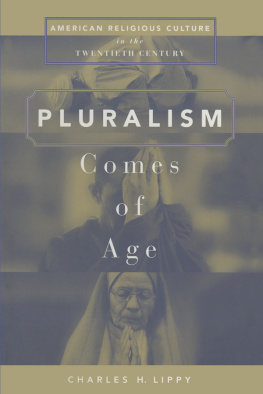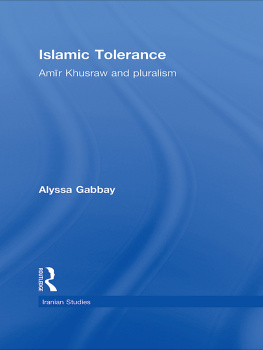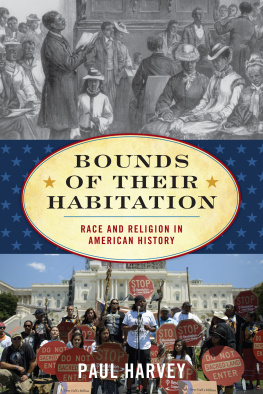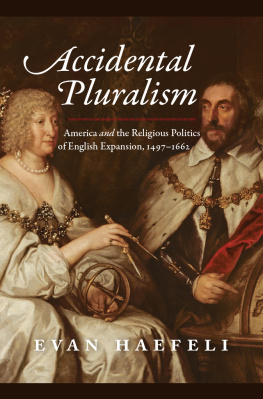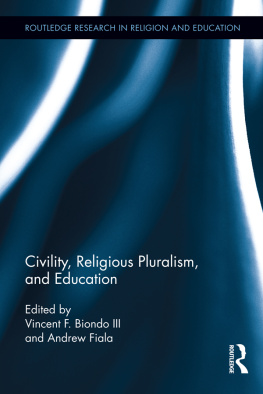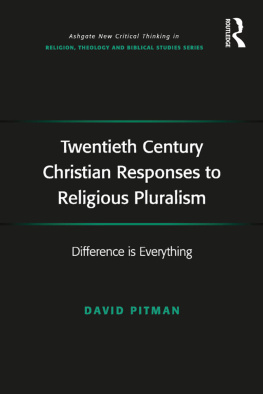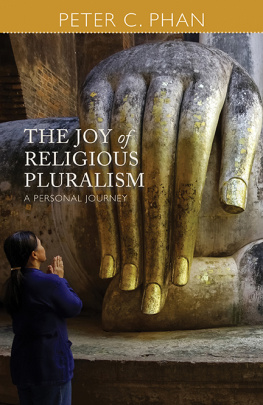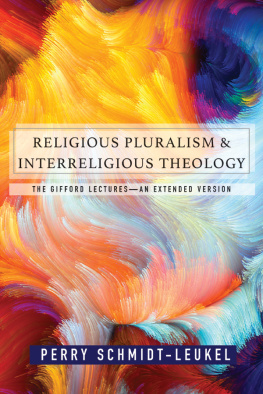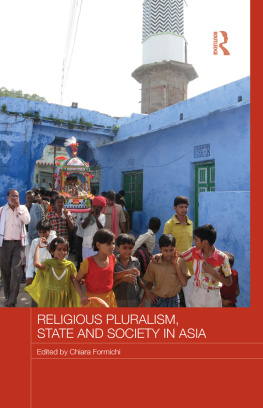Pluralism
Comes
of
Age
PLURALISM
Comes
of
Age
AMERICAN RELIGIOUS CULTURE
in the
TWENTIETH CENTURY
CHARLES H. LIPPY
First published 2000 by M.E. Sharpe
Published 2015 by Routledge
2 Park Square, Milton Park, Abingdon, Oxon OX14 4RN
711 Third Avenue, New York, NY 10017, USA
Routledge is an imprint of the Taylor & Francis Group, an informa business
Copyright 2000 Taylor & Francis. All rights reserved.
No part of this book may be reprinted or reproduced or utilised in any form or by any electronic, mechanical, or other means, now known or hereafter invented, including photocopying and recording, or in any information storage or retrieval system, without permission in writing from the publishers.
Notices
No responsibility is assumed by the publisher for any injury and/or damage to persons or property as a matter of products liability, negligence or otherwise, or from any use of operation of any methods, products, instructions or ideas contained in the material herein.
Practitioners and researchers must always rely on their own experience and knowledge in evaluating and using any information, methods, compounds, or experiments described herein. In using such information or methods they should be mindful of their own safety and the safety of others, including parties for whom they have a professional responsibility.
Product or corporate names may be trademarks or registered trademarks, and are used only for identification and explanation without intent to infringe.
Library of Congress Cataloging-in-Publication Data
Lippy, Charles H.
Pluralism comes of age: American religious culture in the twentieth century / Charles H. Lippy.
p. cm.
Includes bibliographical references and index
ISBN 0-7656-0150-8 (cloth: alk paper) ISBN 0-7656-0151-6 (pbk: alk paper)
1. Religious pluralismUnited StatesHistory of doctrines20th century. 2. United StatesReligion20th century. I. Title.
BL2525.L567 2000
291.172093dc21 |
99-088431 |
ISBN 13: 9780765601513 (pbk)
ISBN 13: 9780765601506 (hbk)
For John F. Wilson
in gratitude for three decades
of quiet inspiration
Table of Contents
Pluralisms Promise and Perils:
American Catholicism in the Twentieth Century
The Paradox of Pluralism:
The Jewish Experience
Religion and the Pride of a People:
Black Religion in the United States
Syncretism and Pluralism:
Native American Experiences in the Twentieth Century
Centuries and even millennia are artificial constructs to historians and analysts of culture. Rarely do movements begin in years ending in 01 and end conveniently 99 years later. So to some extent, this books focus on the twentieth century is a bit misleading. The surge in immigration, the continuing rapid urbanization, and the boom in industrial growthand the religious changes accompanying themthat marked the first decade of the century were part of trends that began two or three decades earlier. Hence the twentieth century for our purposes here really stretches back to the postbellum period. Likewise, it became increasingly clear to me that World War II marked a watershed in American religious life in ways that I had not fully appreciated as one born during the war and growing up in the 1940s and 1950s. For analytical purposes, it marks the end perhaps not of a century but of many of the ways of thinking and operating in the religious sphere that had been a matter of course since the end of the Civil War.
Nevertheless, when one looks at the twentieth century as encompassing the period from 1901 through 2000, one has a helpful lens through which to examine changes and trends, even if there are some abrupt shifts along the way. When I surveyed American religious life through that lens, what stood out first was the incredible pluralism that seemed to invade every facet of the story. American religious culture at the close of the twentieth century is more diverse and considerably more complex than it was at the dawn of the centuryand all the richer as a result. It is that story that I set out to tell in the pages that follow. Some might argue that what I present is really simply a portrait of increasing diversity; I hope that I am able to show that the shifts in the century when taken together are more than that. Together they mean that pluralism, an experiment in religious culture with roots in the colonial past, has come of age.
Work on this book received support from many sources. A summer research stipend from the Louisville Institute in 1998 allowed me to devote three months to preparing the initial drafts of Chapters four and six. Comments and discussion at the Louisville Institutes Winter 1999 Forum stimulated much reflection and revision. I am grateful to my department head, Herbert Burhenn, and then-dean Timothy Summerlin for approving a reduction in my teaching responsibilities in the Spring of 1999 that permitted me to complete the first draft of the whole. Paul Schadewald at Macalester College and David Roebuck, director of the Dixon Pentecostal Research Center and Archive, painstakingly read the complete manuscript and offered more sage advice than I took. I am most appreciative of their willingness to share their wisdom and expertise. It has also been a joy to work with Peter Coveney and the staff at M.E. Sharpe.
Charles H. Lippy
University of Tennessee at Chattanooga
Pluralism
Comes
of
Age
In his now famous endeavor to explain the American experience to a European audience in the 1840s, the Frenchman Alexis de Tocqueville noted that the Christians of America were divided into a multitude of sects. In this way, de Tocqueville highlighted what has since become a commonplace: In the United States religious pluralism prevails. When de Tocqueville wrote, that pluralism usually referred to the multiplicity of Christian groups that flourished on American soil. At the dawn of the twenty-first century, religious pluralism still prevails in the United States, but it is a different sort of pluralism than one marking a multitude of [Christian] sects. In the twentieth century, religious pluralism came of age, for now pluralism encompasses not merely a host of groups clustered under the Christian umbrella. Changes within denominations increased pluralism as well. A range of worship styles may exist within different congregations of the same Christian group; for example, Methodists whose worship music comes from guitar, keyboard, tambourine, and drums augmented by the latest high-tech amplification system are part of the same denomination as Methodists who still look to the majestic organ to guide congregational singing. Among Christians, both Protestant and Catholic, Pentecostal and charismatic expressions became accepted from the 1960s on outside of the historic Pentecostal denominations.
Pluralism points also to the way different ethnic heritages may bring a variety of styles to a given religious tradition. African-American Protestant groups are different from other Protestant religious families in part because of the African ethnic component. Hispanic Catholicism looks and feels different from Irish or Italian Catholicism, even though all are part of the same Christian body in the United States.
Today pluralism embraces not only Christian groups, but an increasing number of non-Christian traditions, including but not limited to Judaism, Islam, Buddhism, and the Hindu religious tradition. In addition, pluralism provides a lens through which to view distinctive approaches to individual spirituality that gained currency during the twentieth century. One obvious example is the mushrooming of approaches to personal spirituality that emerged from womens experience, ranging from a recovery of pre-Christian pagan elements to a recasting of traditional Christian belief in feminist terms.
Next page
